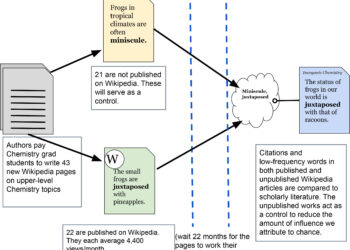During the recent Frankfurt STM Conference, a panel of CEOs agreed with the basic premise that scholarly publishing hasn’t changed that much. While some vehemently disagreed on Twitter, I think that fundamentally, they were correct. There is an entrenched stasis in scholarly communication in which the core elements of the system have not been much moved by the revolutions happening around us.
There are of course many ways in which scholarly publishing has been successful at innovating as we’ve moved from the print world and yes, modern digital publishing has all sorts of functionality that wasn’t available in print. But all of this exists within the same paradigm. We are still bound to a very traditional model, based on print and established hundreds of years ago. We’re in a mature industry with an increasingly entrenched hierarchy in which our organizational structures and processes have evolved to focus on efficiency. We steer our teams to focus on delivery rather than discovery.
In the world around us, the way in which research is conducted in ALL fields has changed dramatically, thanks to technology – not only science but also across the humanities and social sciences. If there’s one lesson we all learned during the pandemic, it’s that science is not a fixed system of knowledge but is ever evolving, often at a rapid pace given new technologies. (Just one example: over the past two decades, we’ve gone from the original 13-year Human Genome Project to being able to sequence an individual human genome in a matter of hours.) But the ways in which we share and disseminate research are fundamentally the same: publication remains slow, final, and takes place after the research is conducted while discovery is a dynamic process and findings are always subject to revision and refinement.

We have seen more disruptive models emerge (I’m now CEO of one of those upstarts that has matured into a successful “adult” organization). But just as PLOS was heavily criticized and written off during the first years of its existence, we still tend to do the same when more radical new models emerge. The immediate reaction of many (the majority or just the louder voices?) in our industry is not to focus on what we might learn from a new innovation, how it might solve some of the problems we’re all aware of, but to pile on with all the ways in which it’s bound to fail. We’ve seen this over the past couple of weeks with the reaction to eLife’s new model. But this is certainly not a new phenomenon: the same thing happened when initiatives such as Octopus, F1000 and others were launched.
Why might this be? The answers to this are varied and probably depend on where the critiques are coming from. The obvious one – and the one we all tend to fall back on – is that we operate in a conservative system in which change is slow and blocked in large part by a fundamentally broken system of researcher incentives and rewards. While not disputing this, I think that there are internal industry dynamics at work too. For commercial publishers, especially the larger ones, radical change is clearly a threat to a very profitable business model that they want to protect. And for many societies, I wonder if one of the problems isn’t that their publishing divisions are too often forced to answer the wrong question: how can we protect the revenue and return we generate to support all of the good work the society as a whole does? What if they were free to focus exclusively on how to best serve generating broad dissemination and impact for the research of their fields?
This is the first of a series of three posts over the coming weeks in which I want to explore both the case for more radical change and how some are already delivering this. Today, I want to focus on several of the drivers, some of which we experience on an almost daily basis. How often in any given week are you frustrated by:
- The challenge of finding enough qualified reviewers and moving content through peer review in an expeditious way;
- The nightmarish complexity of managing business deals and tracking the associated data;
- Trying to do all of this with systems and technology that simply haven’t kept pace with rapidly evolving needs.
But perhaps more importantly, we’re not meeting the changing needs of our core stakeholders. At PLOS, we’ve been in deep conversation over the past few months with a number of people from four core groups: researchers, senior university administrators, funders, and librarians. Our conversations have been with a selected group who are engaged with the transition to open science (and weighted towards the biomedical sciences) so there’s clearly some inbuilt bias. But I think that my key takeaways have wider relevance.
What’s working and still valued
The good news is that many of the fundamental functions served by publishers are still valued across these stakeholder groups – if not necessarily in the ways in which they are currently performed. In our interviews, the unifying value that all stakeholders appreciate is the basic function of vetting and quality control – in other words, someone I trust telling me that this is worth my time. Peer review sits at the heart of this function but there are growing variations about what it should look like. Linked to this is an appreciation for the curation and discovery layers that are added by publishers, all supporting the need to filter out the noise and surface content that is worth the reader’s time.
No one wants to lose this, although we heard variation by region with traditional metrics and formats holding more sway in the UK and Asia. In these regions we heard that university ranking, results in research excellence assessments, and perceptions of prestige continue to be very important. Similarly, these regions continue to highlight impact factor, journal brand, and pre-publication review as signals of trust and as reputationally important.
While we heard from those who would like to move “beyond the article” (see below), others see the article as an important curation tool for the valuable underlying outputs. This may be particular to the biomedical field, but the decision to publish is seen as a decision by the researchers that their collected evidence has reached a threshold of quality that they won’t likely come back on (a ‘culmination’ of sorts). As such, this barrier is serving the community by filtering the noise.
Frustrations and unmet needs
Unsurprisingly, individuals had their own individual gripes, but we also heard strong convergence across stakeholder groups for a few areas in which the current publishing system is frustrating or even failing core stakeholders. Understanding that ours was a limited and biased sample in some ways, I still see wider relevance for all of us here:
- The researchers we spoke with display multiple levels of frustration, but one of the core ones is feeling obliged to publish in ways that don’t align with their values or serve their research. In other words, publication in highly selective (‘vanity’) journals is seen as a necessary step to secure jobs and funding.
- We also heard frustration from researchers and funders with the “beauty contest” (the competition for increasingly elaborate studies necessary to be published in the journals that “count”). The funders interviewed would prefer to see a rigorous study, even with unimpressive results, published and the researchers moving on to the next interesting question, instead of the long-drawn process of trying to get the study in a ‘vanity journal’ which they see as a waste of money and time.
- We didn’t hear support from any stakeholders for the concept of the version of record (my fellow Chef Lisa Janicke Hinchliffe wrote an excellent overview of the state of the VOR), although there is a requirement for clear labeling of versions and identifying the current ‘authoritative version’. Linked to this was increasing frustration that publishing processes and formats simply haven’t kept pace with modern research and fail to take full advantage of modern technologies. In particular, traditional “fixed” publication doesn’t account for the pace at which research often moves, of the need to update outputs that constantly evolve (such as software and methods).
- While our stakeholders were all staunch supporters of open research, we heard significant divergence from librarians about business models. European library budgeting and negotiating is still heavily linked to the legacy of APCs and assessed by cost per article. In the US, every librarian we spoke to was strongly anti-APC. But all librarians were deeply frustrated with the pain and cost and managing OA deals – whatever their nature – and copyright terms across publishers. And all stakeholder groups expressed concern that moves towards open research would lead to further “land grabs” by large publishers to control yet more of the research enterprise.
Pioneering different futures
As I reflect on what we’ve heard, I see a tremendous amount of opportunity for scholarly publishers to rise to the myriad challenges of our current world by bringing together the promises of open science, digital technology, and equity:
- We need greater trust, not cynicism, about the role of science and its ability to help us tackle the climate crisis, social and political conflict, and more. This requires that knowledge be open and subject to scrutiny.
- In truly harnessing the potential of digital technologies, we need to finally move beyond print processes and start thinking about people, culture, processes, and how technology can be used to place researchers first in delivering services that meet or exceed their expectations.
- Equity is about so much more than business models (although it is also very much about business models). Like many industries, we don’t have a great history here and we need to continue to center equity, not only because it’s the right thing to do, but because we can’t meet the challenges of the future without all voices at the table.
In my next two posts over the coming weeks, we’ll hear more from two leaders who are breaking new ground in science communication. In truly understanding the problems they’re trying to solve and the principle and values on which their work is based, I think we’ll have a better idea of how we can approach more holistic cultural change.
With thanks to my PLOS colleagues Veronique Kiermer and Niamh O’Connor for their partnership in conducting and analyzing the stakeholder interviews.
Discussion
10 Thoughts on "Does Scholarly Publishing Have an Innovation Problem?"
Thank you, Alison. This is really informative and I look forward to reading your next two posts. Innovation is hard since it forces organizations and people to change the way they operate and we know change is difficult. The World has evolved very quickly from print to digital and now mobile in the past three decades.
Many publishers are still grappling with going fully digital and converting to XML, and have not even started transitioning to mobile. Many journal sites are a pain to navigate and use, the content is poorly tagged and organized, the search is not very useful, and on mobile many of the sites are nearly useless and content is hard to access and read. As for authentication and getting access to content, OA has been a great help but a lot of information is still behind paywalls and it is very difficult and expensive to access. I am surprised how many publishers are not able to provide flexible pricing based on location and ability to pay. Why does someone from India have to pay the same price for an article as someone from the US? There are many missed opportunities for revenue due to a one price fits all method.
At CACTUS we have made the discovery, engagement, reading, and access to content a lot easier and faster through our free R Discovery app. We know many people are mobile-first so we want to meet them on their mobile devices rather than force them to change their habits. Happy to have a chat with people who want to learn more about what we are doing, show a demo, share our future plans, and how you can join us. Thanks, Jay chirag.patel@cactusglobal.com
I’m really pleased to see this Alison, thank you! I felt the same after the STM day at FBF – we need to innovate as an industry and engage with the wider research community to change the way things have always been done. I’m glad to see someone picking up that challenge and look forward to your next posts.
Thanks for this series, Alison; I’m looking forward to the next two posts. I have one question regarding this statement: “Linked to this was increasing frustration that publishing processes and formats simply haven’t kept pace with modern research and fail to take full advantage of modern technologies.” To what ‘modern technologies’ does this refer? We hear this often, with no specification as to what this means. Clarity would be helpful for all of us. Thanks!
Thanks, Karen! I don’t think I have a specific answer or solution here – the goal of our interviews was to better understand unmet needs and frustrations. So our conversations focused on what people would like to be able to do that they either can’t do or can’t do well now, rather than the specific technology solution to address those deficits. Many of the answers we heard centered on greater speed and flexibility on the publication process whether related to versioning, sharing different outputs or providing context for different audiences. Hope this is helpful.
I look forward to reading more in this series. My take on this is that there is innovation and glacial change. It’s kind of like watching your kids grow up—you don’t notice them growing snd they are suddenly adults, taller than you. There is tremendous innovation—as you mention, your company is an example. DOIs, Open Access. But fundamentally research and publishing isn’t broken: it works, at least to an extent. Disrupters come in thinking “Publishing is broken” and find things are not so simple. Most publishers are Janus: with an agile start up side and a “this is how we’ve always done things” side. I describe publishing as “a stable landscape of continuous change.”
Thanks, John. I completely agree with you about continuous change and that scholarly publishing has been good at adapting (though not sure that “glacial change” really fits the definition of innovation!). The bigger question I’m interested in is this: given the transformative change in how research itself is conducted, in technology and in so many other aspects of our lives, should we be satisfied with a system that merely “works…to an extent”?
Many thanks to Alison for what promises to be a fascinating series of posts. At the same time I do think somebody needs to play devil’s advocate here…
When I was doing a proper job at CUP we always got far more grief from faculty for things we had once done but no longer did (like collating published reviews) than we ever did for any perceived lack of innovation, something which was invariably seen as publisher-driven and publisher-centric rather than author-driven and author-centric (as with almost every new workflow/technology initiative). Indeed, innovation seemed to be the very last thing that most of our authors wanted. Maybe mine was an outlier experience but, in the course of publishing directly something like a thousand academic books and editions, over the years, this would have been an emphatic conclusion.
Which is another way, perhaps, of saying that in some fields (and particularly some text-based fields) modes of working haven’t, actually, changed all that much for a large number of scholars (hence, also, perhaps the survival of print as the preferred medium for long-form reader access), who, for the intellectual questions that they are trying to answer, find established practices moreorless satisfactory. To which the counter-argument (not least from the critical digital humanities) is that both questions and practices should change, and scholarly publishers should actively promote that change.
Nonetheless there is a tension here that we do need to recognise, and one in which key intermediaries (including, of course, academic libraries) find themselves caught in the middle. Tim Elfenbein’s point, that the key divisions in schol comm are not necessarily those between publishers and universities, but between different constituencies within universities, remains very apposite.
Right, I shall now take cover!
No need for cover, Richard – there’s much we agree on here and I appreciate your thoughtful engagement. And yes, you highlight one of the key challenges: scholarly publishers serve a constituency that is conservative and change averse in many ways (something I always find ironic given the spectacular creativity in the research itself!). You’re absolutely right about differences across fields and the continued importance of long-form scholarship – though in my time as a university press director I heard plenty of frustrations from humanists that whatever their field (art, music, film), their outputs were constrained by textual formats.
The life sciences are undoubtedly different but beyond these differences across fields, I wonder how well the current static and somewhat archaic system is set up to handle the challenges of our world. We learned a lot about what does and doesn’t work in research communication in times of crisis over the past few years and yet there’s been little lasting change. It seems to me that this warrants some deeper reflection if we’re to play our part in addressing the myriad other crises across the globe right now.
Thank you for generously sharing insights from the work with your stakeholders and the work of your colleagues with the community.
An article by David W. Lewis in College and Research Libraries 73(5) called ‘The inevitability of Open Access’ predicted that 90% of articles could be Open Access by 2020 if there was ‘disruptive innovation’ in academic publishing. The fact that we continue to see growth in paywalled content (despite adding Gold OA on top) is evidence that this disruptive innovation hasn’t come about.



